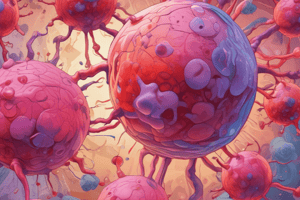Podcast
Questions and Answers
What is the primary function of antibodies?
What is the primary function of antibodies?
- Activate T cells to kill infected cells
- Stimulate the release of histamine
- Mark antigens for phagocytosis by macrophages (correct)
- Destroy pathogens directly
What is the role of plasma cells in the immune response?
What is the role of plasma cells in the immune response?
- They produce and release antibodies (correct)
- They directly kill infected cells
- They act as antigen-presenting cells
- They stimulate the production of T cells
Which of the following cells are directly responsible for releasing platelets into circulation?
Which of the following cells are directly responsible for releasing platelets into circulation?
- Lymphocytes
- Megakaryocytes (correct)
- Neutrophils
- Erythrocytes
What is the primary role of platelets in hemostasis?
What is the primary role of platelets in hemostasis?
How does fibrin contribute to the formation of a blood clot?
How does fibrin contribute to the formation of a blood clot?
Which of the following cells is NOT a type of leukocyte?
Which of the following cells is NOT a type of leukocyte?
Which of these statements accurately describes the role of sebum in the immune system?
Which of these statements accurately describes the role of sebum in the immune system?
During diapedesis, neutrophils move through the endothelium of blood vessels. What is the driving force behind this movement?
During diapedesis, neutrophils move through the endothelium of blood vessels. What is the driving force behind this movement?
Which of the following statements accurately describes the role of macrophages in the immune response?
Which of the following statements accurately describes the role of macrophages in the immune response?
Where do T cells mature and acquire antigen receptors?
Where do T cells mature and acquire antigen receptors?
What is the primary role of cytotoxic T cells in the immune response?
What is the primary role of cytotoxic T cells in the immune response?
Which of the following cells is NOT a professional antigen-presenting cell?
Which of the following cells is NOT a professional antigen-presenting cell?
What occurs when a naive T cell encounters a dendritic cell displaying an antigen that matches its receptor?
What occurs when a naive T cell encounters a dendritic cell displaying an antigen that matches its receptor?
Flashcards
T helper cell function
T helper cell function
Triggers B cell division and maturation in the immune response.
B cell clonal expansion
B cell clonal expansion
Process where B cells multiply to produce plasma cells and blasts after activation.
Role of plasma cells
Role of plasma cells
Plasma cells produce and release antibodies (immunoglobulins) into the bloodstream.
Platelet origin
Platelet origin
Signup and view all the flashcards
Formation of a blood clot
Formation of a blood clot
Signup and view all the flashcards
Sebum
Sebum
Signup and view all the flashcards
Mucociliary clearance
Mucociliary clearance
Signup and view all the flashcards
Diapedesis
Diapedesis
Signup and view all the flashcards
Neutrophils
Neutrophils
Signup and view all the flashcards
T Cells
T Cells
Signup and view all the flashcards
Clonal expansion
Clonal expansion
Signup and view all the flashcards
Cytotoxic T Cells
Cytotoxic T Cells
Signup and view all the flashcards
B Cells
B Cells
Signup and view all the flashcards
Study Notes
Immune System Protection
- The skin provides a protective barrier against foreign substances, with sebaceous glands producing sebum, an oily fluid containing antimicrobial elements.
- Sebum maintains a symbiotic relationship, killing harmful microbes while supporting beneficial ones.
- Mucous membranes in the nose, mouth, and trachea have cilia that move mucus containing foreign substances upwards.
- Mucociliary clearance removes unwanted particles from the lungs and trachea via coughing and exhaling.
- Bone marrow contains stem cells that differentiate into daughter cells—either stem cells or progenitor cells—forming various immune cells (leukocytes), including neutrophils.
- Neutrophils, part of the innate immune system, traverse blood vessels during inflammation.
- Diapedesis is the process of neutrophils passing through blood vessel endothelium, aided by chemotaxis, following cytokines released by other cells.
- Neutrophils phagocytose bacteria and release cytokines, attracting other granulocytes and macrophages.
- Macrophages arrive before neutrophils, phagocytizing bacteria and producing tumor necrosis factor, a signal suppressing hunger, inducing fever, and stimulating leukocyte production.
T Cells and Immune Response
- T cells recognize antigens presented by macrophages or antigen-presenting cells.
- T cells mature in the thymus, acquiring antigen receptors.
- Naive T cells encounter dendritic cells in secondary lymphoid organs (lymph nodes and spleen).
- Dendritic cells display antigens, triggering T cell activation if the antigen matches the T cell receptor.
- Activated T cells undergo clonal expansion, producing many antigen-specific cells.
- Cytotoxic T cells identify and induce apoptosis in infected cells.
- Helper T cells collaborate with B cells.
B Cells and Antibody Production
- B cells originate in bone marrow, seeking specific antigens.
- Upon antigen recognition, B cells activate or migrate to lymphoid tissue to encounter helper T cells.
- B cells present antigens for T helper cell recognition.
- T helper cell recognition triggers B cell division and maturation.
- B cells expand clonally, producing plasma blasts and plasma cells.
- Plasma blasts and plasma cells release antibodies (immunoglobulins) into the bloodstream.
- Antibodies bind to toxins, antigens, and pathogens, inactivating toxins and marking antigens for macrophage phagocytosis (opsonization).
Platelets and Hemostasis
- Platelets (thrombocytes) develop from megakaryocytes in the bone marrow.
- Megakaryocytes release platelets into circulation via pseudopodia.
- Platelets circulate and adhere to collagen fibers after blood vessel injury.
- Platelets aggregate, forming a fragile platelet plug.
- Fibrin strands strengthen the plug, binding platelets and red blood cells, creating a stable clot.
Studying That Suits You
Use AI to generate personalized quizzes and flashcards to suit your learning preferences.




